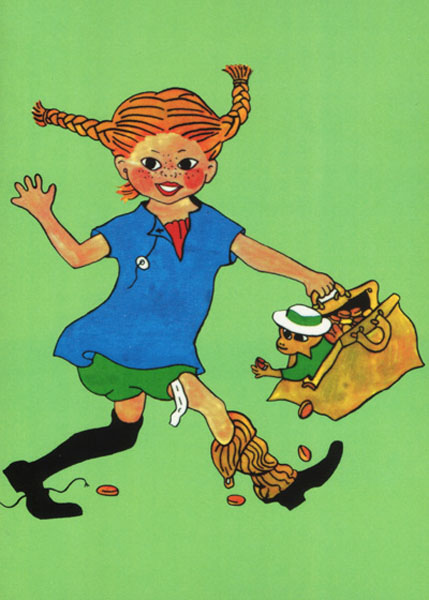
Pippi Longstocking. Ingrid Vang Nyman, for the Pippi Longstocking series by Astrid Lingren, 1946. WikiCommons.
Pippi Longstocking, whose amazing full name is Pippilotta Delicatessa Windowshade Mackrelmint Ephraim’s Daughter Longstocking, is a one-of-a-kind girl from a series of Swedish books written by Astrid Lindgren in the 1940s. The Pippi stories were written for Lindgren’s daughter when she was home sick from school. The character of Pippi has parallels to other children’s characters, like Peter Pan, with her general ‘I do not want to grow up’ attitude.
Pippi lives in an adult-free environment with no family around, on her own in an old villa. Though she only has a horse and monkey for company, she is not lonely. She is completely capable of looking after herself, using skills she learned from her father, who is alive, but out having adventures of his own on the high seas. Also beneficial is her superhuman strength, with which she protects herself and her friends.
Her appearance is well described in the books and is as much a part of her unique character as her behavior. The original illustrations were done by Ingrid Vang Nyman. Pippi is very distinctive, with bright orange hair that is always made up in gravity-defying pigtails and symbolic of Pippi’s seemingly boundless energy. Pippi has her own sense of style that completely expresses her unconventional and unpredictable personality. Her patchwork clothing demonstrates her ability to sew and resourcefulness to make do. The colors that she uses also emphasize her unconventional personality, as they are traditionally masculine colors.
A lack of manners and sense of authority makes her appear uncivilized and her willfulness makes her seem naughty, but it is mainly because of having to look after herself and having no boundaries that she appears this way. Along with her two friends, Tommy and Annika, who have a stable two-parent family and go to school, they all learn to appreciate the freedoms and responsibilities of life and are grateful for what they have.
In the way she’s drawn, both Pippi and her adventures are a clear alternative to the clean-cut children primarily illustrated in the 1940s.
